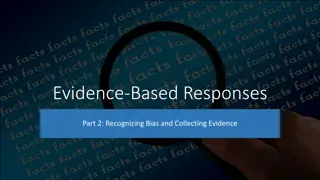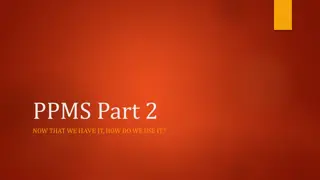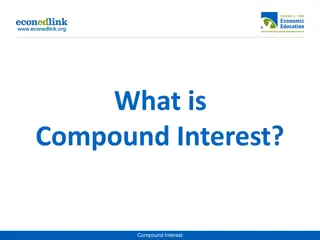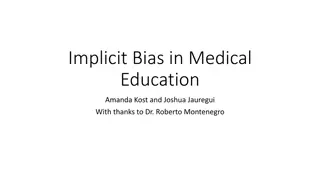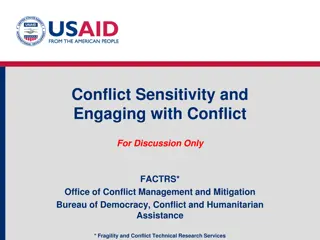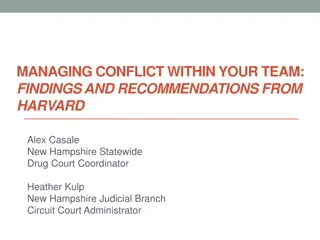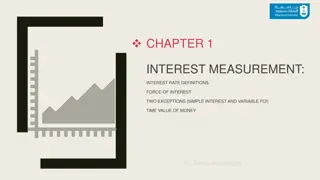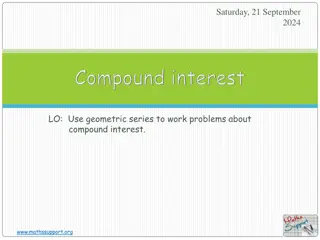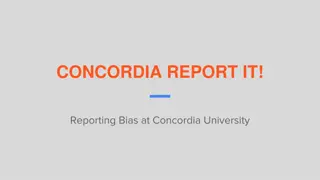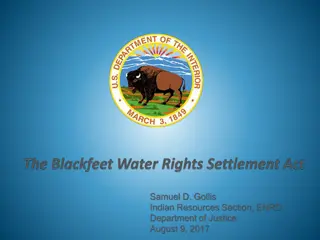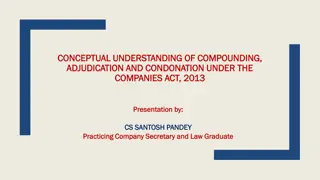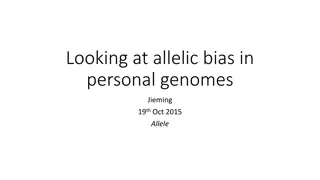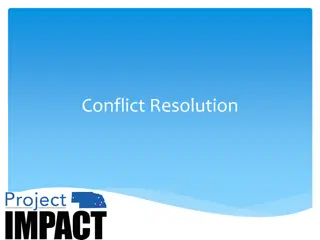Investigating Bias and Conflict of Interest: Guidelines for Fair Adjudication
Explore the intricacies of bias and conflict of interest in investigations, learn how to identify and counteract them to ensure fairness in decision-making. Topics include understanding bias, detecting it, LGBTQ terminology, evidence collection, and remedial actions like recusal. Navigate the nuances of explicit and implicit biases, factors influencing investigations, and the implications of conflicts of interest on judgment and decision-making. Discover remedies and procedures to maintain impartiality throughout the investigative process.
Download Presentation

Please find below an Image/Link to download the presentation.
The content on the website is provided AS IS for your information and personal use only. It may not be sold, licensed, or shared on other websites without obtaining consent from the author. Download presentation by click this link. If you encounter any issues during the download, it is possible that the publisher has removed the file from their server.
E N D
Presentation Transcript
Session 5: Bias and Conflict of Interest HOW TO INVESTIGATE AND ADJUDICATE WITHOUT BIAS OR CONFLICT OF INTEREST (PLUS ADDITIONAL CONTENT)
Agenda What is bias and conflict of interest How to detect bias and conflict of interest Bias in investigations and decision-making Remedies and recusal LGBTQ Terminology Evidence collection considerations Statement analysis
What is Bias? Prejudice in favor of or against one thing, person, or group compared with another, usually in a way considered to be unfair (Oxford Languages) Explicit: individuals are aware of their prejudices and attitudes towards certain groups Positive or negative preferences Implicit: all of the subconscious feelings, perceptions, attitudes and stereotypes that have developed as a result of prior influences and imprints. Automatic positive or negative preference for a group, based on one s subconscious thoughts. Confirmation: tendency to search for, interpret, favor, and recall information in a way that confirms or supports one's prior beliefs or values. Harvard Implicit Association Test
Bias and Investigations In determining whether an individual was harmed or has committed the act: Prior conduct history Role in the complaint (complainant/victim, respondent/accused) Neurobiology of trauma Attitude and demeanor Appearance Gender and race (actual or perceived) Personal experiences Prior trainings (content and presenter) Employment Memberships to organizations
What is Conflict of Interest? Occurs when an individual's personal interests family, friendships, financial, or social factors could compromise their judgment, decisions, or actions Past experiences personal and professional Past and current relationships Position at work
Remedies and Recusal What involved parties can do: Challenge appointment Process within the policy for challenging assigned investigator and decision What adjudicators can do: Check your bias. Individuation. Perspective taking. Conflict check. Two investigators. Recuse yourself.
LGBTQ+ Terminology LGBTQ+ - Umbrella term referring to individuals who are lesbian, gay, bisexual, transgender, queer, asexual, or intersex. Biological Sex internal and external genitals and reproductive organs Intersex sexual characteristics of both genders Gender not inherently connected to biology Gender Identity how gender is labeled Gender Expression external display of gender
LGBTQ+ Terminology Transgender umbrella term for people whose gender identity differs from the sex assigned at birth Cisgender individual identifies as their sex assigned at birth Genderqueer don t identify with binary definitions Gender nonconforming outside behaviors assigned to gender at birth Gender fluidity range of gender identity Transition process of asserting sex corresponds to gender
LGBTQ+ Terminology Sexual orientation romantic/physical attraction to others Asexual individuals who do not experience sexual attraction Pansexual attracted to members of all gender identities Transphobia discrimination directed at those who are trans A Comprehensive LGTBQ+ Terminology List available on the NIU Gender and Sexuality Resource Center webpage (https://www.niu.edu/gsrc/gender-sexuality/lgbtq/terminology.shtml)
Evidence Collection Electronic Evidence (i.e., text messages and call logs)
Evidence Collection iMazing oiPhone app that can transfer text messages and call logs from iPhone to PC or Mac. The iPhone ios has a screen recorder feature that allows users to record the screen on their phone (e.g. Snapchat) without notifying other parties. How to enable on iPhone: o Settings > Control Center > Customize Controls, then tap + next to Screen Recording. How to access on iPhone: o Swipe up from the bottom edge of any screen. oPress the record button to start and stop recording. oVideo saved in phone s photo album.
Social Media Accounts Helpful to ask parties if they have more than one account. o It is common for people to have a second account on the same social media platform. Sometimes, the second account is the user s real account for friends and is not known to a user s parents, family, and family friends. o The second account displays more real life, imperfect photos, struggles, and memes o For example, a second or fake Instagram account is commonly referred to as a Finsta.
Virtual Interviews Enable video. Make sure the party is somewhere private that they can speak freely. Ask if anyone else is in the room with them. Scan the room. Recordings are not permitted during investigation. Hearings are recorded.
Statement Analysis - Pay Attention To Note: Analysis of a person s verbatim words. Pauses: indicative of thinking or formulating a response. Document pauses. May need to follow- up during interview to determine why they paused. Unique sensory details Equivocations and negations Extraneous information Statement Balance: Prologue, Incident, and Epilogue
Statement Analysis Sensory Details Details that go above and beyond normal details; indicators of veracity (truthfulness) o Unique Sensory Details (i.e., sight, sound, touch, smell, taste) o Spatial Details o Emotions (e.g. fear, anger, embarrassment, love, surprise, disgust, shame) o Examples: Toyota truck v. blue Toyota pick-up truck Something hit me v. Someone kicked a soccer ball at my face. In the corner v. In the corner of the living room behind the couch. She got on top of me v. I felt her weight on top of my chest.
Statement Analysis Equivocations Terms allowing the speaker to evade the risk of commitment. Non-committal words. Indicators of deception, unwillingness or inability to provide further information. Often a person is able to provide an explanation for WHY they are unable to provide further information. Commonly used equivocations: o maybe o probably; o think / believe; o assume; o kind of / sort of o basically / around; o To be honest; o Not to my knowledge; I may have; To the best of my
Statement Analysis - Negations No, Not, or any contraction of Not. Offer insight into areas that may become important later in the statement. Especially if subject voluntarily provides negations at the beginning of a statement. Commonly used negations I m not sure I don t remember I don t recall I don t know Negations and equivocations in response to an open-ended questions are the best indicators of deception.
Statement Analysis Extraneous Info Anything that does not answer the question asked. Example: Answering a question with a question. Used to justify the speaker s actions. Used to fill space or buy time. Is speaker trying to convey or convince?
Statement Analysis Statement Balance Prologue provides content for the incident This should be the second largest portion of the statement If the prologue is larger than the incident, it may be indicative of deception. Incident When the subject senses a threat through when the subject no longer feels the threat. This section should be the majority of the statement Epilogue final or concluding act or event.


